Ms. Surber’s 2004–2005
Class
4th Grade, Barron Park School
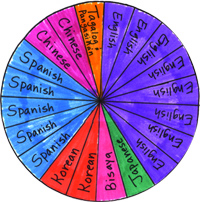
On September 9, 2004, we recorded interesting facts about our class that were displayed in 68 bar graphs and Venn diagrams in our room.
Here are some examples of the charts and graphs we used to collect and display our data. This Venn diagram shows our lateral dominance, and this shows what we collect. This bar graph illustrates our favorite fruits, and this one shows our heights. This circle graph (pie chart) shows the languages we speak at home.
Pairs of students in our class created portraits of Geometrics (creatures composed of geometric shapes) and wrote descriptions of the Geometrics. Students in our partner class at Escondido tried to re-create our Geometrics after reading our descriptions while we did the same for theirs. Then we compared the original Geometrics portraits with the recreations and evaluated our descriptions. Visit our Geometrics webpages to see our completed project.
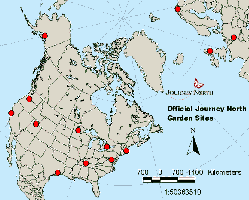
We joined classrooms all across the Northern Hemisphere in a telecommunication project to track the progress of spring by observing the emergence of tulips. Our class will serve as one of the 13 Official Journey North Tulip Gardens. Our first activity was predicting what order the 13 Official Tulip Gardens would bloom. Students used three main strategies for deciding which locations would experience spring first: spring would come later to latitudes closer to the North Pole, for locations at the same latitude those nearer an ocean would bloom first, and personal experience with climate in locations close to the official gardens. Our class prediction:
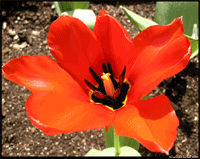 To
begin our Tulip Project, each
student measured the circumference of
a tulip bulb, weighed it, and then
predicted when that bulb would emerge and bloom in relation to the rest of
the class bulbs.
We made sketches of our bulbs (more
sketches) and learned about the parts of the bulb. We dug
six inch holes, planted, and watered our
bulbs on December 9th. The weather was sunny and the temperature was 62° F.
(Here is our
data form at the Journey North website.) Since the squirrels think our
tulips bulbs make tasty snacks, we protect our planter box with a squirrel
guard. We cut the extra bulbs in half and sketched the internal
structure of the tulip bulbs (more
sketches). We discovered that the tulip bulbs are made of many
layers surrounding the bloom bud. On January 31st, we observed that our
first tulips had emerged; here is our data
report. You can track the progress of spring (measured by the blooming
tulips) by looking at the weekly
maps. Our first tulips bloomed on
March 3rd; here is our data
report. By the end of the week our entire tulip bed was in bloom.
To
begin our Tulip Project, each
student measured the circumference of
a tulip bulb, weighed it, and then
predicted when that bulb would emerge and bloom in relation to the rest of
the class bulbs.
We made sketches of our bulbs (more
sketches) and learned about the parts of the bulb. We dug
six inch holes, planted, and watered our
bulbs on December 9th. The weather was sunny and the temperature was 62° F.
(Here is our
data form at the Journey North website.) Since the squirrels think our
tulips bulbs make tasty snacks, we protect our planter box with a squirrel
guard. We cut the extra bulbs in half and sketched the internal
structure of the tulip bulbs (more
sketches). We discovered that the tulip bulbs are made of many
layers surrounding the bloom bud. On January 31st, we observed that our
first tulips had emerged; here is our data
report. You can track the progress of spring (measured by the blooming
tulips) by looking at the weekly
maps. Our first tulips bloomed on
March 3rd; here is our data
report. By the end of the week our entire tulip bed was in bloom.
A description of our Tulip Project is featured in Intel’s An Innovation Oddessy. I also wrote the unit plan for Intel’s Innovation in Education: The Wave of Spring.
We collected data about Matadero Creek this year. You can learn more by visiting our Matadera Creek Data page.
Passport to California and Suitcase Presentations: We enjoyed hearing the stories of how our families came to California. Here is the data about the arrival of our families in California:
| When | Who | From Where | Journey | Why |
|---|---|---|---|---|
| 1926 | Ms. Surber | West Brook, Texas (via Colorado) | truck, 3 years | good farmland |
| 37 Years Later | ||||
| 1963 | Jordan | Tucson, Arizona | plane & car, 1 day | work |
| 7 Years Later | ||||
| 1970 | Yuta | Tokyo, Japan | plane, 17 hours | to join family |
| 7 Years Later | ||||
| 1977 | Ilse | Acapulco, México | plane, 4 hours | to join family |
| 1978 | Skyler |
Summit, New Jersey |
van, 10 days |
graduate school |
| Tom | Richland, Washington | car, 2 days | Stanford University | |
| 2 Years Later | ||||
| 1980 | Alex | Guadalajara, México | bus, 2 days | better job |
| 2 Years Later | ||||
| 1982 | Michaela | South Colton, New York | plane, 6 hours | death in family |
| 4 Years Later | ||||
| 1986 | Anna | Beijing, China | plane, 14 hours | graduate school |
| 3 Years Later | ||||
| 1989 | Anthony |
Guatemala City, Guatemala |
bus, 1 week |
to start a new life |
| Cory | Guadalajara, México | car, 3 days | to live in California | |
| Ivan | Durango, México | bus, 3 days | to join family | |
| 1990 | Guayo | St. Louis, Missouri | plane, 7 hours | job |
| 3 Years Later | ||||
| 1993 | Janine | Cebu, Philippines | plane, 13 hours | marriage |
| 1994 | Boot | Vietnam (via Florida) | U-Haul, 6 days | to live by ocean |
| 1995 | Elana | Boston, Massachusetts | plane, 6 hours | to be with family |
| 5 Years Later | ||||
| 2000 | Arthur |
Chicago, Illinois |
truck, 3 days |
better weather |
| Yang | Beijing, China | plane & car, 4 months | to join family | |
| 4 Years Later | ||||
| 2004 | Nicole | Ft. Leavenworth, Kansas | car, 3 days | army |
| Yoo Sun | Seoul, Korea | plane, 11 hours | to study | |
| Rose | Seoul, Korea | plane, 13 hours | Stanford University | |
California Geography: Geography was our first unit in Social Studies. We learned about latitude and longitude and how to read all types of maps of California. Our final project was to make a relief map of the our state. We sketched the major geographical features of the state of California on large boards and modeled the mountains and valleys with a goopy mixture of salt and flour. After the “goop” dried, we painted the elevations and the surrounding states. Finally we located five important cities and made a key. We agreed that this was a fun and messy project! The finished maps were quite impressive. Here are two examples, two more, and two more.
Investigating Artifacts: In the first section of this unit we walked to Bol Park to collect natural materials which we sorted and classified. We used our natural materials for a math lesson on Venn Diagrams. It was fun trying to figure out the Secret Sorting Rule of each Venn Diagram: Venn Diagram #1, Venn Diagram #2. Most were very hard to guess! Then we made masks (more masks). In the second section we listened to myths, wrote our own myths, created posters (more posters) to illustrate the myths, and shared our myths around a “campfire” in our classroom. In the final section of the unit we excavated “middens” by carefully sieving the soil, cleaning and polishing the artifacts, and recording the spot where each artifact was discovered with a sketch. The completed midden maps (another midden map) and museums (another museums) helped us draw inferences about the culture from the artifacts we found.
California Explorers: Each group chose an explorer who was important in the history of California. Students made timelines of California and placed their explorers in time, made maps to show where the explorers traveled, drew portraits of what the explorers might have looked like, and wrote essays about the goals and accomplishments of the explorers. Then each group created a poster and made a presentation to the rest of the class. Explorers we learned about:
Mission Period: Each student chose one of the 21 California Missions as the topic of a research report. We learned how the Spanish changed the lives of the Native Californians and wrote letters from the perspective of a Native American who had joined a mission. Our final project was creating a HyperStudio stack to publish our reports.
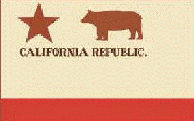 Americans
Arrive:For this period of California history, we shifted perspective
and looked at California from the American point of view. We learned about
the fur traders that opened new routes to California, and the reaction to
the news of the new land to the west they took back to the United States.
We tried to understand the hard decisions pioneers from the United States
traveling to California in wagon trains had to make along the way. Then we
studied the Bear Flag Revolt of 1846, which proclaimed California an independent
republic. The California Republic lasted for less than three weeks, but did
influence our state flag! In his memoirs, the Recuerdos (Recollections),
General Vallejo wrote, “the bear looked more like a pig than a bear.”
Americans
Arrive:For this period of California history, we shifted perspective
and looked at California from the American point of view. We learned about
the fur traders that opened new routes to California, and the reaction to
the news of the new land to the west they took back to the United States.
We tried to understand the hard decisions pioneers from the United States
traveling to California in wagon trains had to make along the way. Then we
studied the Bear Flag Revolt of 1846, which proclaimed California an independent
republic. The California Republic lasted for less than three weeks, but did
influence our state flag! In his memoirs, the Recuerdos (Recollections),
General Vallejo wrote, “the bear looked more like a pig than a bear.”
Gold Rush: The Room 17 Gold Rush was a great success! Our miners struck it rich at the Bol Park Gold fields and then spent most of their money in our gold rush town. The Stakes & Claims Assay Office was efficient and well organized. The Miners Mutual Bank did a booming business buying gold from the miners for $16.00 an ounce. Our hungry and thirsty miners didn’t mind the high prices at The Buckstar Café, there was a good selection of goods at the Gold Pan General Store, and the show performed by Hangtown Hoedown was hilarious.
All About Us: Our first math unit is an introductory data collection and graphing unit. We started by collecting some information about our class. We learned all sorts of interesting things about our class and organized our data with bar graphs and Venn diagrams. Here are some examples of the charts and graphs we used to collect and display our data. This Venn diagram shows our lateral dominance, and this shows what we collect. This bar graph illustrates our favorite fruits, and this one shows our heights. This circle graph (pie chart) shows the languages we speak at home.
Mathematical Thinking in 4th Grade: We finished our second math unit by creating symmetrical designs. We began by reviewing Mirror Symmetry. We created some designs that had both Mirror and Rotational Symmetry. The hardest was creating designs that had Rotational Symmetry but NOT Mirror Symmetry.
Arrays and Shares: In our third math unit we practiced our multiplication facts through 12 x 12 and working on multiplication and division problems.
Landmarks in the Thousands: In our fourth math unit we investigated our number system by working with problems in the 100s and 1000s. The final activity for this unit was making a 10,000 chart, which was huge!
Equal Shares, Different Pieces: We explored fractions in this unit. While looking at fractions as equal area divisions, we made Quilts of Fourths (more examples).
Money, Miles, and Large Numbers: We worked with decimal numbers in this unit.
Area and Perimeter: In this unit we began by figuring the area and perimeter of our feet. Then we investigated the different perimeters possible for one area and the different areas possible for one perimeter by designing banquet tables and gardens.
The Shape of the Data: In this unit we collected and organized data and learned about statistics. We collected data about our families, compared the heights of 1st and 4th graders, and investigated sleep patterns. The range of our school night sleep was 7 to 11 hours and 5.5 to 11 hours on weekends.
Packages and Groups: In this unit we practiced multiplication and division with two and three digit numbers.
Sunken Ships and Grid Patterns: We learned how to do coordinate graphing in all four quadrants and how to program the computer using LOGO commands to make geometric shapes and patterns.
Appearances: Our first book had two stories linked by the theme of not judging by appearances: “Brother to the Wind” and “The Cat Who Thought She Was a Dog and the Dog Who Thought He Was a Cat.”
Island of the Blue Dolphins, by Scott O’Dell, helped us understand the life of the Chumash. We illustrated our favorite parts of the book captioned with a quote from the novel. We wrote poems using similes (a favorite literary device of Scott O’Dell) and created crayon and water color art projects featuring organisms from the book (four watercolors and four more watercolors). For our final activity we watched the movie adaptation of the book and discussed the similarities and differences.
Babe, the Gallant Pig, by Dick King-Smith, was fun to read even though the dialect was often difficult to understand. We learned many new vocabulary words about sheep herding and discovered how being brave and polite can lead to success. The final activity for this book was to create ribbons (three examples & three more & a final three examples) summarizing how each character helped Babe achieve his goal.
Literature Circles: In Literature Circles we practice and refine
the skills needed to participate in book discussions: choosing discussion
questions, leading a discussion, making connections between literature
and real life, learning new vocabulary words, identifying and appreciating
literary elements.
• Among the Hidden, by Margaret
Peterson Haddix
• Pigs Might Fly, by Dick King Smith
• Tales
of a Fourth Grade Nothing, by Judy Blume
• A Long Way from Chicago, by Richard
Peck
• Frindle,
by Andrew Clements
• Maniac
Magee, by Jerry Spinelli
• Ralph
S. Mouse, by Beverly Cleary
• Loser,
by Jerry Spinelli
• Matilda,
by Roald Dahl
In the Year of the Boar and Jackie Robinson, by Bette Bao Lord, helped us to understand what is was like to immigrate to the United States from China in 1947.
By the Great Horn Spoon!, by Sid Fleishman, was a funny historical fiction about a boy and his butler who traveled to the gold fields in California from Boston around Cape Horn.
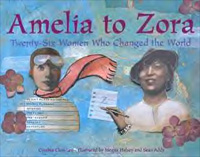 This
Amazing Woman Inspires Me: After reading Amelia to Zora: Twenty-Six
Women Who Changed the World, by Cynthia Chin-Lee, our students wrote
essays about a woman who inspired them. Some student chose to enter their
essays into a writing contest sponsored by the author of the book. Two
students from our class won Honorable Mention for their essays: Elana
and Rose!
This
Amazing Woman Inspires Me: After reading Amelia to Zora: Twenty-Six
Women Who Changed the World, by Cynthia Chin-Lee, our students wrote
essays about a woman who inspired them. Some student chose to enter their
essays into a writing contest sponsored by the author of the book. Two
students from our class won Honorable Mention for their essays: Elana
and Rose!
Mission Reports: Each student selected one of the 21 California missions as the subject of a research report. We practiced many report-writing skills: skimming for specific information, note taking, organizing information, presenting factual information accurately and in an interesting way, writing a bibliography. After taking notes we wrote rough and final drafts for each section. For the final draft we used a program called HyperStudio. Students learned how access the tool pallets and drawing tools to create a floor plan of the mission. When the text on a page is done, students learned to use the painting tools to decorate the page.
Mission Letter: Each student wrote a letter from the persepective of a Native American child living at a missiion. The letter described both the advantages and disadvantages of mission life and then gave advice to an imaginary cousin about the wisdom of coming to join the mission.
Water: Our first science unit was the study of water. We observed several properties of water: surface tension, rate of flow, and expansion/contraction with changes in temperature. We observed that hot water (tinted red) floats in a glass of room temperature water while ice cold water (tinted blue) is so dense that it remains in the small vial at the bottom of the cup. (picture of experiment) We also investigated how location and surface area influence the rate of evaporation and explored condensation. Using a chemical indicator, we tested to see if water samples were hard or soft. We investigated what happens when water flows over different Earth materials and tested water from home. We built water wheels to experiment with the way water flows.
Magnetism & Electricity: In this unit we experimented with magnetism, conductivity, series and parallel circuits, and electromagnets. The final activity of our study of Magnetism & Electricity was to build a telegraph and send messages in code. Then we shared what we had learned about Magnetism & Electricity with the rest of the class by building Quiz Boards with aluminum foil circuits, building a lunchbox alarm, constructing a robot, and creating a clapping duck.
 Animal
Studies: In this life science unit we observed and cared for Dwarf
African Frogs, Fiddler Crabs, and Land Snails. We learned many interesting
things by watching our animals and taking accurate observational notes.
The final activity was for each group to choose a question that could
be answered by observation. Each group then presented the results of
their observations to the rest of the class. The investigation questions
were:
Animal
Studies: In this life science unit we observed and cared for Dwarf
African Frogs, Fiddler Crabs, and Land Snails. We learned many interesting
things by watching our animals and taking accurate observational notes.
The final activity was for each group to choose a question that could
be answered by observation. Each group then presented the results of
their observations to the rest of the class. The investigation questions
were:
 Art
ArtCreatures: Three students worked together to make different sections of imaginary creatures. Here are two examples and two more.
Quilts: Each student will make a Crazy Quilt with a different design in each quilt piece. The finished individual quilts are displayed together in a class quilt which symbolizes all of the different personalities that are joined together into one whole classroom community. Here are four example quilts, four more, four more, and the last four.
Symmetrical Butterflies: After studying mirror symmetry we made butterflies with cut paper. Here are two examples, another two, and two more.
Island of the Blue Dolphins: After reading Island of the Blue Dolphins, by Scott O’Dell, we created crayon and watercolor pieces depicting symbols from the book. Here are four examples and four more.
Native American Symbols: After studying Native Americans we created works featuring symbols like the thunderbird, a quail and thunderbird, the sun, a mask, and sky symbols.
Explorer Portraits: We learned to make portraits while studying explorers. Here are portraits of Juan Bautista de Anza, Álvar Nuñez Cabeza de Vaca, Hernán Cortés, Sir Frances Drake, and Sebastián Vizcaíno.
Mission Prints: We sketched our missions, used carbon paper to reverse our sketches, traced the carbon paper onto foam board, and then printed. This was a long and messy project, but the prints were amazing! Here are four examples and four more.
Name Bugs: These art pieces (NameBugs and More NameBugs and Even More NameBugs) illustrate the work we are doing with cursive, mirror symmetry, contrasting colors, and positive and negative space.
Rouault Court: We painted self portraits in the style of Georges Rouault, who was a stained glass artist before becoming a painter.
Stuffed Animal Day: November 24th was Stuffed Animal Day: Ms. Surber’s Stuffed Animals
Career Day: December 16th was Career Day. In Room 17 we had doctors, chefs, soccer players, gardeners, teachers, and many other careers.
Crazy Hat or Hair Day: On January 27th, Barron Park School was full of students and adults showing their school spirit by appearing in a crazy hat or with crazy hair!
100th Day of School: On February 4th we did activities with 100 to celebrate the 100th Day of School. All of our math problems featured the number 100. Lots of people wore 100 things: stripes (Ilse, Skyler, Yoo Sun), flowers (Ms. Surber, Elana, Rose), stitches (Cory), dots (Guayo), sparkles (Michaela), watch band plates (Tom). Anna wrote 100 Chinese characters and Rose collected 100 signatures. Many of us brought 100 things to eat: chips & cookies (Ilse), raisins (Ms. Surber), pretzels (Anna), Cheerios (Janine), popcorns (Skyler), corn (Rose), M&Ms nuts (Yoo Sun), Cheese Nips (Anthony), sprinkles (Michaela), marshmallows (Jordan), animal crackers (Arthur). These students earned certificates for being at school on time for 100 Days: Yoo Sun, Anthony, Anna.
 Read
Across America & Pajama Day: On March 2nd we celebrated reading
by reading to ourselves and each other for most of the day while lounging
comfortably in our pajamas!
Read
Across America & Pajama Day: On March 2nd we celebrated reading
by reading to ourselves and each other for most of the day while lounging
comfortably in our pajamas!
Clone Day: On March 17th the Room 17 Clone dressed alike in blue jeans, white shirts, bandannas, and a green shamrock.
Beach Day: On May 13th we celebrated the end of STAR testing by wearing our beach clothes, picnicking on the lawn, playing with beach balls, and eating popsicles.
![]()
Website for Ms. Surber’s Current Class